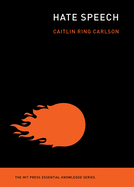
Hate speech is not a new phenomenon, but how many people truly understand what it is, and what it is not? In Hate Speech, Caitlin Ring, professor in the Communication Department at Seattle University, clearly sets out various definitions of hate speech, while examining how different countries have grappled with their historical problems with it, the violence it can lead to and how it can be countered both legally and socially.
Carlson dives into the histories of the U.N., the E.U. and countries such as South Africa, the U.S., Japan, Rwanda, Germany and Brazil to trace how hate speech leads to trauma for its victims and to their dehumanization, and she highlights why this must be countered in a society. She also explains how social media and the Internet have complicated the management of hate speech. By looking at the problem as "a structural phenomenon in which those in power use verbal assaults and offensive imagery to maintain their preferred position in the existing social order," Carlson moves the onus of response away from individuals and onto governments, corporations and international bodies. She also examines the particular case of the protection of free speech versus the protection of hate speech in the U.S. and how attempts to limit hate speech can be used to instead limit protest speech against those in power. Carlson presents a compelling view of a problem that seems to have no good answer, and yet she provides suggestions for methods that might help to end the easy spread of hate speech in media and online. --Michelle Anya Anjirbag, freelance reviewer

